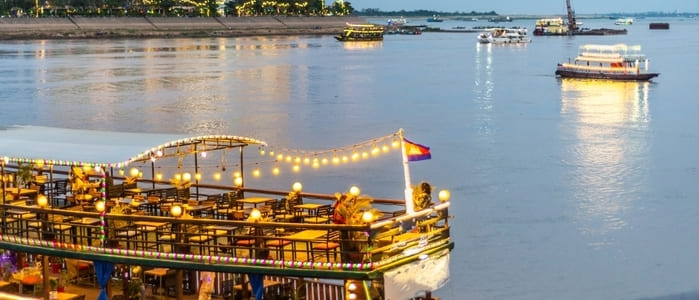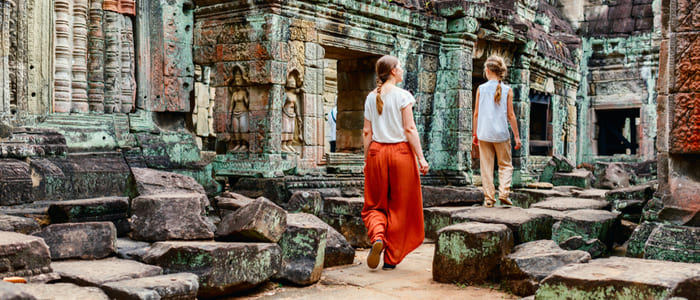
A Cambodia river cruise offers you a captivating journey along one of the world's most iconic waterways, the Mekong.
However, navigating the visa requirements for a Mekong cruise through Cambodia can be complex, as the rules vary depending on your cruise itinerary and point of entry.
That’s where our team at CambodiaGoVisas can help. On this page, we break down the options for a Cambodia river cruise visa, including the Cambodia eVisa and D transit visa, to help you find the right option.
You’ll also find practical information to help you effectively prepare for your trip.
Visa Requirements for Cambodia River Cruises
If you’re entering Cambodia by air or land before joining a river cruise, there are 3 options depending on your nationality:
- Use the eVisa system to get your Cambodia visa in advance
- Obtain a physical visa from a Cambodian embassy in your home country
- Queue for a visa on arrival at Techo International or Siem Reap airports
The Cambodia eVisa is available to over 200 nationalities and is the most convenient option.
Some of the benefits of getting your eVisa with CambodiaGoVisas in advance include:
- No need to visit an embassy, the process is 100% online
- Avoid waiting in long queues for a visa on arrival
- Pay via credit or debit card (no need to carry cash to pay in person)
- The peace of mind of having your essential travel documents arranged in advance
Additionally, unlike some of the other Cambodia visa types, the eVisa permits you to spend an extended period in the country, up to 30 days. This allows you ample time to explore the rest of Cambodia before or after your Mekong river cruise.
Mekong river visa requirements for entering Cambodia from Vietnam
If you’re entering Cambodia via a Mekong River cruise from Vietnam, you should be aware that the Cambodia e-Visa is not accepted at the waterway border.
Instead, if you’re crossing from Vietnam into Cambodia, cruise lines typically arrange for visas for a Mekong cruise onboard for passengers. This process requires one passport photo and a visa fee of $35-50 USD in cash per person.
Do I need a visa to visit Cambodia on a cruise ship?
Visitors arriving in Cambodia at a seaport by cruise ship generally require a visa, even if they do not plan to leave the ship.
However, you should note that the Cambodia eVisa is not accepted at seaports, including common cruise-docking ports such as Sihanoukville, Phnom Penh, or Koh Kong.
Instead, a new short-term transit visa (D category) was introduced in 2023 specifically for cruise ship tourists. This visa allows a stay of up to 96 hours (4 days), and can be obtained through consulates or authorized travel agencies.
CambodiaGoVisas recommends contacting your cruise provider for the most up-to-date information on visa procedures for your particular trip.
Cambodia River Cruises: An Overview
Mekong River cruises offer diverse itineraries for both upstream and downstream travel, and can range from a day trip to up to 8 days or more.
A popular 8-day downstream cruise begins in Siem Reap, Cambodia and ends in Ho Chi Minh City, Vietnam (formerly Saigon). The upstream route reverses this journey.
The itinerary often includes stops in Phnom Penh, Kampong Cham, and Tonle Sap Lak before crossing into Vietnam to My Tho, Cai Be, Sa Dec, and Chau Doc.
Longer 10-night cruises may extend into Laos and Thailand, offering a more complete experience.
Sample Mekong River Cruise Itinerary
A typical downstream Mekong River cruise from Cambodia to Vietnam begins in Siem Reap, gateway to the ancient Angkor temples, before embarking on the cruise proper.
Key stops include:
- Day 1-2: Explore Tonle Sap Lake and Kampong Chhnang, known for its floating villages and rural scenery
- Day 3: Visit Phnom Penh, Cambodia's capital, to see the Royal Palace and National Museum
- Day 4-5: Cross into Vietnam, exploring Chau Doc and Sa Dec
- Day 6: Experience the floating markets of Cai Be and the Mekong Delta
- Day 7: Disembark in My Tho or Ho Chi Minh City
Be aware that if your itinerary ends in Vietnam, you may need a visa to enter the country. Depending on your nationality, you may be eligible to get a Vietnam e-Visa online in advance.
Best Months to Cruise the Mekong River
Here's a summary of what weather to expect on a Mekong River cruise depending on when you visit:
| Month Range | Season | Characteristics |
| November - February | Dry season | Best overall weather, cooler temperatures, lower humidity |
| March - April | Late dry season | Hotter temperatures, still dry |
| May - October | Wet season | Higher water levels, lush landscapes, fewer tourists |
The best time to cruise the Mekong River is generally during the dry season, which offers optimal weather conditions for river travel.
Therefore, November to February is considered the peak season for Mekong River cruises, offering comfortable temperatures and minimal rainfall.
However, the wet season can provide unique experiences such as fuller rivers and greener landscapes, despite the risk of short, heavy rain showers.
Our team at CambodiaGoVisas recommend you consider your preferences for weather, crowds, and scenery when choosing the best time for your Mekong cruise.
Additional tips for a Cambodia river cruise
Finally, consider the following tips to ensure your Mekong River cruise goes as smoothly as possible:
- Pick a reputable operator
Opt for a cruise line that has a solid track record of satisfied passengers, is well-established, and reputable. - Purchase comprehensive travel insurance
This should cover medical emergencies, trip cancellations, and other unforeseen situations. - Pack appropriately
Bring lightweight, breathable clothing, comfortable walking shoes, and modest attire for temple visits. - Bring cash in the correct currency for daily expenses
US Dollars are widely accepted in Cambodia, but you’ll need to bring some Vietnamese Dong if crossing into Vietnam. - Stay healthy
Get recommended vaccinations, bring anti-diarrheal medication, and stick to bottled water to avoid foodborne illnesses.


